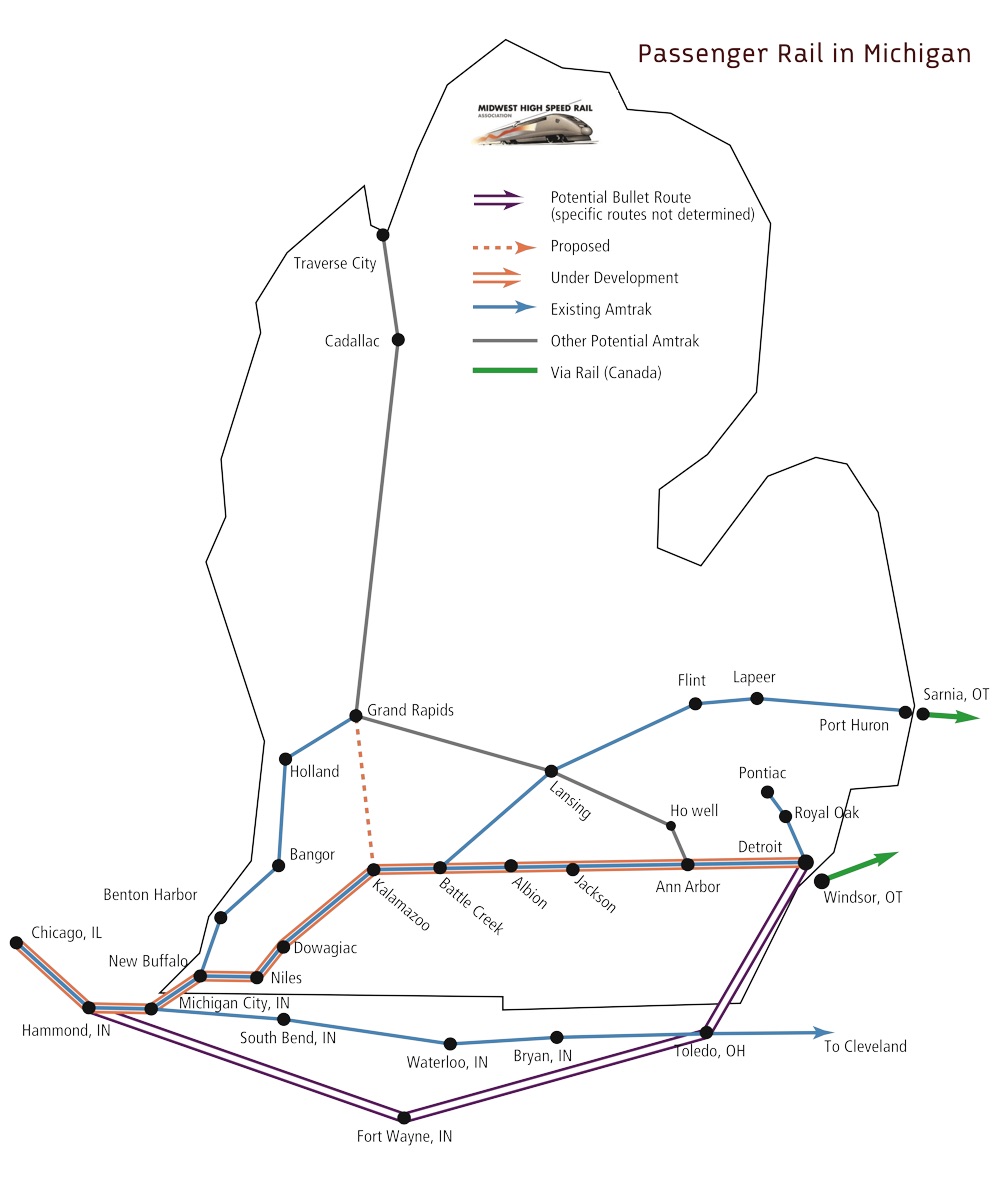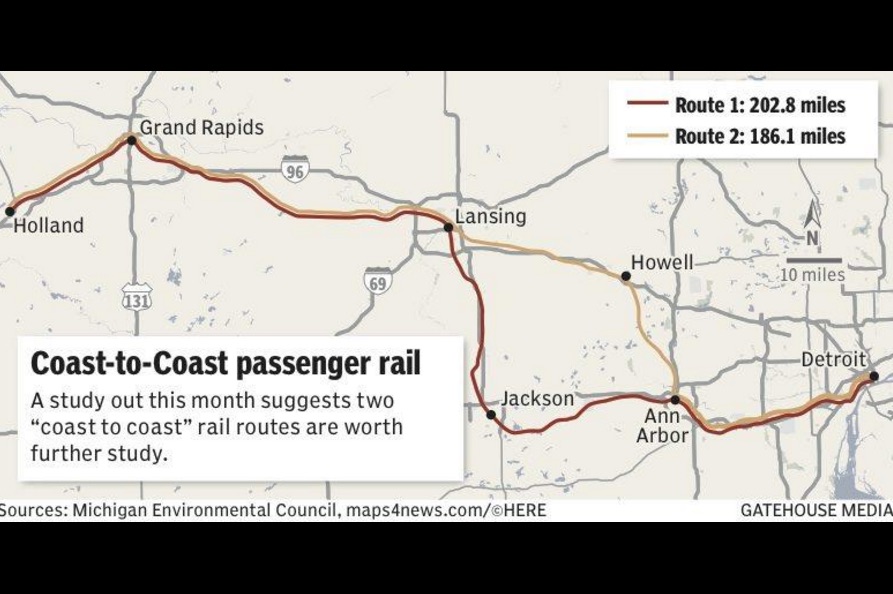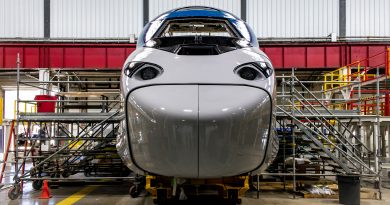High-Speed Rail– Maybe For The Next Generation
Growing up on the east coast, I was initially bemused upon hearing the frequent grumbling by Midwesterners about Amtrak when I arrived in Iowa in 2008. I learned fairly quickly that the Northeast Regional, the Pennsylvanian, and the Keystone Service are pretty unusual routes– operating profitably, punctually, and frequently. So, I’m naturally always excited about any possibility of new infrastructure investment that will mean I can take a train rather than sit on a Michigan freeway being passed by aggressive drivers in Mexican-made Fords while I’m already traveling at 75mph (120km/h).
MLive recently reported a proposal to build a high-speed rail route to Holland from Detroit, either via Howell (a small town between Lansing and Detroit) or Jackson (a right angle out of the way, but the current Amtrak stop). By 2040. Wait, I was with you until then, but… 2040?
Proposed improvements were previously reported as increasing the maximum speeds from 65 miles per hour (104km/h) to a blistering 79 miles per hour (127km/h). As MLive reports:
“[e]stablishing daily Michigan passenger railroad service between Detroit and Holland could cost between $124 million and $540 million, but it might also generate about $14 million in annual revenue depending on train speed and routes, according to an exploratory study.”
That’s a pretty big range. Now, I don’t work in finance or anything, but I might be off when I suggest that a project that costs 40-50 years to pay off might just be a little bit more expensive than the average public transit program. Or it might be indicative of decaying infrastructure that desperately needs to be repaired– or infrastructure that should be subsidized while we are instead subsidizing other infrastructure. Based on these figures, we see that the (projected) costs would then make both projects comparably priced by around 2065, when I’m going to be retired:
| Max speed | Initial cost | 10yr cost | 20yr cost | 30yr cost |
| 79 mph | $131,000,000 | $167,000,000.00 | $203,000,000.00 | $239,000,000.00 |
| 110 mph | $540,000,000 | $400,000,000.00 | $260,000,000.00 | $120,000,000.00 |
Turns out the high-speed system would cost a lot more to build but would actually be profitable, eventually, as opposed to snail rail, which would require a subsidy. The study that proposed all of this based this assumption on the increased frequency of high-speed trips (more train trips because the trains go faster). While the study notes potentially conflicting variables that could encourage or discourage train travel (respectively, increasing cost of fuel and the hassle of congestion, especially increased congestion– or, to discourage rail travel, the increasing fuel efficiency of vehicles), the same study fails to take into account the potentially deleterious effects that rising diesel fuel costs– part of that same fuel variable- would have on the high-frequency, high-speed diesel trips.
The Sluggish Climate of Midwestern Rail Spending
Elsewhere, Midwestern high-speed rail development drags on. And on. Chicago seems to be a major linchpin– or impediment, depending on how you want to look at it- in the Midwestern transit infrastructure, and I have closely followed the CREATE initiative, which basically seeks to reduce the degree to which the Windy City essentially slows down the entire economy of the country through freight congestion. The St. Louis to Chicago route, which I have taken in its low-speed configuration, has, it seems, been nearing completion for several years now, although it is (supposedly) set to be completed by the end of 2017, resulting in a near-first world average speeds of 110mph, a 40% increase in speed.

The Long Track Ahead
Since the year is still 1959 and we’re living in the era of automotive hegemony, we have to address a deficit of knowledge and interest that is as cultural as it is economic– in other words, even if we had the appropriations to spend on studies, and even if we weren’t giving tax breaks to General Motors and were instead spending money on railroads, we’d have to sell the dream in order to cop the dollars. These amounts of money pale in comparison to the cost of interstate highway spending, which works out to a few million dollars per mile since 1957, whichever way you look at it, so, comparable to the cost of rail but excluding the massive accompanying subsidy to the automotive and oil sectors, but we still are just not at the point of instead accepting rail, culturally. You see television ads for Dodge Rams towing improbably large trailers through the American Southwest at breakneck speeds, but you don’t see ads of an Amtrak train towing a multitude of American workers toward a great, productive tomorrow. (The latter doesn’t glorify the American mythos of the sacred individual– duh.)
After getting used to seeing so many anti-rail articles begin with the phrase, “According to Randal O’Toole of the Cato Institute […]” I’ve enjoyed seeing some vaguely positive, if not dreamily-far-off portrayals of high-speed rail from the likes of even CNN. Still, we’ve got a long ways to go.
http://www.urbanophile.com/2016/03/18/why-you-should-think-twice-before-building-a-rail-transit-system/
Non-Tooles, including Edward Glaeser and Aaron Renn (above) are concerned with the costs of construction and maintenance, and point out (correctly) that this stuff costs a lot of money to build and a lot to maintain. But few have taken a comprehensive, comparative approach to the complete cost of transit, comparing rail (isolated, permanent infrastructure) to highways (heavily subsidized, dependent upon exorbitant things called “cars,” plagued by expensive congestion) to air (heavily subsidized in the form of oil subsidies, massive municipal construction projects for highways and airports). Maybe I’ll save that for a future article.
The one thing I can say? I sure don’t need a 313-page study to tell me that I would prefer sitting on a train to sitting in a car to cross the state.




